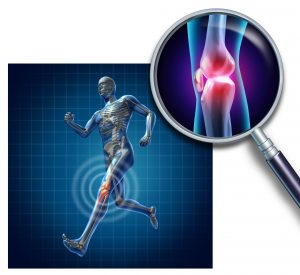 Sports injuries, such as concussions and injured Anterior Cruciate Ligaments (ACLs), are common occurrences across a wide variety of sports. While both injuries are well known, Sport Injury FAQs are helpful in learning about cause, prevention, and treatment among athletes.
Sports injuries, such as concussions and injured Anterior Cruciate Ligaments (ACLs), are common occurrences across a wide variety of sports. While both injuries are well known, Sport Injury FAQs are helpful in learning about cause, prevention, and treatment among athletes.
One very common topic of sport injury FAQs are concussions. They are very common injuries in sports and are also difficult to diagnose. A concussion is a traumatic brain injury that affects the way the brain functions. While the effects are temporary, concussions do have the potential to leave long term, lasting effects on the brain. Most people associate concussions with head injuries. Few know that concussions can also be caused by being violently shaken or impacted which occurs often in contact sports. Follow along for important sport injury FAQs from Louisville sports medicine physician Dr. Stacie Grossfeld.
Sport Injury FAQs
What is the average return to playtime in the NBA in reference to a concussion?
Dr. Padaki, et al, published in the September 2016 issues of the American Journal of Sports Medicine that the number of concussions involving NBA players from the beginning of 2006 to the end of the 2014 season has not changed; however, what has changed is that the time a player sits out of games after getting a concussion has increased.
While players often returned within the same game in the 2006 season, NBA players are now missing games. Players sit out an average of five games after getting a concussion.
While concussions are common sports injuries that need to be taken seriously, they are also quite easy to recover from when not extremely detrimental and diagnosed early. An ACL injury, on the other hand, is a serious muscle injury that comes with a long recovery time regardless of if your injury is nonsurgical or surgical. Part of that recovery time includes heavy physical therapy which plays an important role in regaining strength in the muscles and getting back into your normal routine. Injured ACLs are another hot topic in Sport Injury FAQs because the ACL is not as commonly discussed as concussions are and people have many more questions about them.
Does age influence the risk of knee osteoarthritis after traumatic ACL injury?
Studies have shown that the risk of osteoarthritis after sustaining an ACL injury can increase by up to 85%. The question authors answered in a 2016 article published in the American Journal of Sports
Medicine was “does age specifically influence the risk of osteoarthritis occurring after an ACL injury?”
Dr. Victoria Jonson, et al, reported on a group of patients who had undergone primary ACL reconstruction over a 15-year period. She found that the age of the athlete in which the injury occurred did not influence the rate of incidents.
What they did find is that the middle aged athletes were likely to encounter osteoarthritis in the endpoint soon. That could also be explained by the fact that osteoarthritis can be part of the natural aging process.
What is the hormone, Relaxin, and does it have any effect on an ACL injury?
There was an excellent article written in the September 2016 Journal of American Sports Medicine. Jacqueline Konopka, BS, at Stanford Medical Center looked at the hormone, Relaxin, and its effects on female ACL ligament cells.
It is a fact that female athletes sustain ACL injuries 2 to 8 times more often than male athletes. Specific gender related factors like: anatomy, biomechanics, and hormones may contribute to the disparity in tear rates between the genders. The author specifically wanted to investigate if the female hormone, Relaxin, could affect ACL cells.
The Study
This was a laboratory study in which ACL cells were primed with estrogen and treated with Relaxin. The authors wanted to find out if potentially blocking the hormone could affect ligament strength. There are some completed studies that reveal that a lead female athlete with an ACL tear had higher levels of Relaxin concentrations circulating through their bodies in comparison to a female athlete without any injury. Additional studies have shown that animals treated with Relaxin had significantly weaker ACLS as measured by load to failure testing in comparison to controls.
During the study, it was also considered that men do have significant serum levels of the hormone Relaxin. It is possible that chronic Relaxin exposure among women decreases the integrity of the female ACL which in turn contributes to the gender disparity in the ACL injury prevalence.
Background
Background information as to the structure of the ACL includes that it is primarily composed of Type I, Type II, and Type III Collagen. Type I Collagen is the most abundant matrix component and is responsible for the majority of the ACL’s tensile strength. Type II Collagen is found at fibrocartilaginous areas of the ACL that undergo high levels of sheer force. The main type of collagen is Type III which is synthesized during the early stages of ACL healing. Degradation of these important ACL matrix components could possibly lead to a higher risk of ACL injury.
Research Process
It is known that Relaxin promotes connective tissue degradation by decreasing levels of collagen and alpha smooth muscle actin as well as decreasing transforming growth factor beta activity by inhibiting certain enzymatic pathways. Because of this, it has been theorized that chronic exposure to Relaxin does predispose the female athlete to an increased risk of ACL injury. What the researchers found is that the hormone Relaxin did not bind to male ACL tissue, but did bind to female ACL tissue suggesting a differential gender dependence response to Relaxin.
They also found that female ACL cells that had been exposed to oral contraceptive did not have similar regulation or experience the binding effect of Relaxin, so the authors concluded there may be a protective effect to ACL injuries if a female athlete is taking an oral contraceptive. There are some clinical studies that have suggested this as well.
Results
The result of the laboratory study was that chronic Relaxin exposure could biomechanically compromise the integrity of the female ACL by decreasing collagen level production.
Some clinical studies in the past have revealed that female athletes with serum Relaxin levels greater than 6.0 pg/mL were found to have over four times increased risk of ACL injury that females with lower levels of the hormone in their bodies.
The researchers felt that the goal would be to enroll the women at higher risk for ligamentous injury into a prophylactic injury prevention program to decrease the gender disparity in the female athlete spectrum.
These Sport Injury FAQs are much more detailed questions and elaborate answers due becuse Dr. Stacie Grossfeld wrote them. Dr. Grossfeld is a Louisville, KY orthopaedic surgeon and sports medicine specialist. In addition to her practice as an orthopaedic surgeon, Dr. Stacie Grossfeld is an Assistant Clinical Professor at UofL in the Department of Family Medicine. She also assists at the Department of Internal Medicine and Pediatrics. She is a member of Baptist Sports Medicine and enjoys serving as the Team Doctor for South Oldham High School. In addition, Dr. Grossfeld is the Team Doctor for Assumption High School in Louisville, KY.
 The final diagnosis is made postmortem when the brains are identified and found to have increased TAU protein and widespread neurofibrillary tangles (NFTs). In the past, CTE was called punch drunk syndrome. Doctors, such as Ann McKee, and Dr. Bennet Omalu (is most famously known for his lead role in the movie Concussion, which Will Smith was the actor representing Dr. Bennet Omalu). These doctors have suggested that CTE has a clear environmental origin. The groups have proposed that head injury, both concussive and sub-concussive, leads to neuropathic changes and the subsequent development of a series of neuropsychiatric symptoms, behavior changes, and cognitive defects.
The final diagnosis is made postmortem when the brains are identified and found to have increased TAU protein and widespread neurofibrillary tangles (NFTs). In the past, CTE was called punch drunk syndrome. Doctors, such as Ann McKee, and Dr. Bennet Omalu (is most famously known for his lead role in the movie Concussion, which Will Smith was the actor representing Dr. Bennet Omalu). These doctors have suggested that CTE has a clear environmental origin. The groups have proposed that head injury, both concussive and sub-concussive, leads to neuropathic changes and the subsequent development of a series of neuropsychiatric symptoms, behavior changes, and cognitive defects.
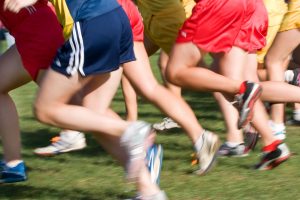 Anterior Cruciate Ligament, often referred to as ACL injuries, are the most common knee injuries athletes suffer. While an extremely active individual could possibly suffer this type of injury, an ACL tear is most common in athletes. This is because of the stop and start movements associated with sports such as football, basketball, hockey and more. The anterior cruciate ligament is on the inside of the knee joint and supports the shin bone. The ligament, knee, and shin work together to prevent the tibia from sliding out in front of the thigh bone.
Anterior Cruciate Ligament, often referred to as ACL injuries, are the most common knee injuries athletes suffer. While an extremely active individual could possibly suffer this type of injury, an ACL tear is most common in athletes. This is because of the stop and start movements associated with sports such as football, basketball, hockey and more. The anterior cruciate ligament is on the inside of the knee joint and supports the shin bone. The ligament, knee, and shin work together to prevent the tibia from sliding out in front of the thigh bone.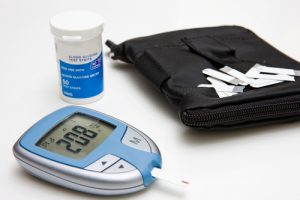 physicians are concerned with surgical outcomes in patients with diabetes. Several studies, papers and research has been published on diabetes and surgery. In one example, a doctor wanted to take a closer look at the effects of arthroscopic rotator cuff repair and surgery in individuals with diabetes. Here is what was published in the
physicians are concerned with surgical outcomes in patients with diabetes. Several studies, papers and research has been published on diabetes and surgery. In one example, a doctor wanted to take a closer look at the effects of arthroscopic rotator cuff repair and surgery in individuals with diabetes. Here is what was published in the  Researchers note that fatty infiltration is one of the most important prognostic factors for anatomic and functional outcomes after rotator cuff surgery. The surgical repair of the torn rotator cuff may not be able to stop or reverse the process of fatty infiltration. Fatty infiltration is when the rotator cuff tendon and muscle turns to fat.
Researchers note that fatty infiltration is one of the most important prognostic factors for anatomic and functional outcomes after rotator cuff surgery. The surgical repair of the torn rotator cuff may not be able to stop or reverse the process of fatty infiltration. Fatty infiltration is when the rotator cuff tendon and muscle turns to fat. Dr. Stacie Grossfeld, board certified Orthopedic Surgeon and Sports Medicine Physician, enjoys some holiday Christmas tree decorating with her team at Orthopaedic Specialists. She chose a red and gold theme for her Christmas tree decorating. In order to find the decorations, Dr. Grossfeld went to Joanne’s Fabrics and Michael’s and looked for pretty decorations that fit the tree.
Dr. Stacie Grossfeld, board certified Orthopedic Surgeon and Sports Medicine Physician, enjoys some holiday Christmas tree decorating with her team at Orthopaedic Specialists. She chose a red and gold theme for her Christmas tree decorating. In order to find the decorations, Dr. Grossfeld went to Joanne’s Fabrics and Michael’s and looked for pretty decorations that fit the tree.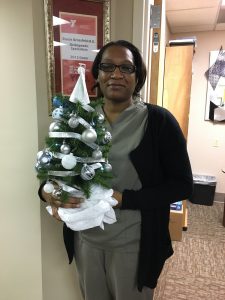 Angel McDowell works in the insurance and billing department at Orthopaedic Specialists. She chose a silver and blue theme for her Christmas tree decorations. Talking about how she chose her decorations, Angel explains: “Me and my son Abram (age 13) were shopping and he helped me pick out the colors for my tree, which was nice.”
Angel McDowell works in the insurance and billing department at Orthopaedic Specialists. She chose a silver and blue theme for her Christmas tree decorations. Talking about how she chose her decorations, Angel explains: “Me and my son Abram (age 13) were shopping and he helped me pick out the colors for my tree, which was nice.” Angel Porter is a physician assistant at Orthopedic Specialist PLLC in Louisville, Kentucky. She chose a Star Wars theme for her Christmas Tree decorating. Talking about how she found the decorations, Angel explains: “I raided my boys’ (James, 11 and Noah, 9) rooms and used their legos for the trees. I also found the ribbon at home. The hardest part of making the tree was tying the ribbon at the top. Figuring that out took a while!”
Angel Porter is a physician assistant at Orthopedic Specialist PLLC in Louisville, Kentucky. She chose a Star Wars theme for her Christmas Tree decorating. Talking about how she found the decorations, Angel explains: “I raided my boys’ (James, 11 and Noah, 9) rooms and used their legos for the trees. I also found the ribbon at home. The hardest part of making the tree was tying the ribbon at the top. Figuring that out took a while!” Ashley is an X-Ray Tech and Medical Assistant at Orthopaedic Specialists. She chose a Dr. Seuss Theme for her Christmas tree. Ashley enjoys searching Pinterest for good tree decorating ideas and that’s how she settled on the Dr. Seuss theme. After Christmas, she’ll enjoy taking the tree home to her 3 children, ages 5, 8 and 9.
Ashley is an X-Ray Tech and Medical Assistant at Orthopaedic Specialists. She chose a Dr. Seuss Theme for her Christmas tree. Ashley enjoys searching Pinterest for good tree decorating ideas and that’s how she settled on the Dr. Seuss theme. After Christmas, she’ll enjoy taking the tree home to her 3 children, ages 5, 8 and 9. Dorothy Cochran runs the Medical Records Department at Orthopaedic Specialists, and she also serves as the Work Comp Coordinator and Appointment Scheduler. When she started figuring out how to decorate her Christmas tree, she went to Hobby Lobby.
Dorothy Cochran runs the Medical Records Department at Orthopaedic Specialists, and she also serves as the Work Comp Coordinator and Appointment Scheduler. When she started figuring out how to decorate her Christmas tree, she went to Hobby Lobby. Heather Hardiman is a Medical Receptionist at Orthopaedic Specialists in Louisville Kentucky. She decorated her Christmas tree according to the style that she likes in her home. She used stars, berries, snowmen and woodsy ornaments.
Heather Hardiman is a Medical Receptionist at Orthopaedic Specialists in Louisville Kentucky. She decorated her Christmas tree according to the style that she likes in her home. She used stars, berries, snowmen and woodsy ornaments.


 On the 22nd of November, YMCA of Greater Louisville Chairman, Brad Smith, and Mayor Greg Fisher held a community Thanksgiving breakfast. Dr. Grossfeld attended the event at the Galt House Hotel to learn more about the growth of the Louisville community. The event included a delicious buffet and a performance by America’s Got Talent finalists – Linkin’ Bridge.
On the 22nd of November, YMCA of Greater Louisville Chairman, Brad Smith, and Mayor Greg Fisher held a community Thanksgiving breakfast. Dr. Grossfeld attended the event at the Galt House Hotel to learn more about the growth of the Louisville community. The event included a delicious buffet and a performance by America’s Got Talent finalists – Linkin’ Bridge.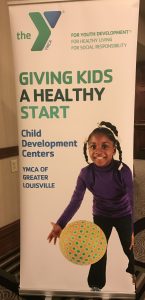

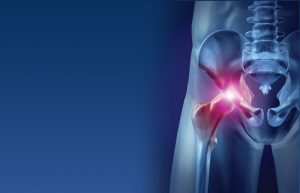 higher incidence of orthopedic conditions associated with age including osteoporosis and osteoarthritis.
higher incidence of orthopedic conditions associated with age including osteoporosis and osteoarthritis. Sports injuries, such as concussions and injured Anterior Cruciate Ligaments (ACLs), are common occurrences across a wide variety of sports. While both injuries are well known, Sport Injury FAQs are helpful in learning about cause, prevention, and treatment among athletes.
Sports injuries, such as concussions and injured Anterior Cruciate Ligaments (ACLs), are common occurrences across a wide variety of sports. While both injuries are well known, Sport Injury FAQs are helpful in learning about cause, prevention, and treatment among athletes. Researchers highlighted background data noting that there is concern right now and actually discussion that the ulnar collateral ligament injury is almost an epidemic affecting pitchers at all levels of baseball from recreational high school players to the pro pitchers. The ulnar collateral ligament reconstruction surgery has been reported to impose an average of 17 to 21 months away from the MLB competition and possibly diminish their performance. If there is a way to curtail the current trend and protect the integrity of the elbow joint in pitchers, that would be the best form of treatment would be prevention.
Researchers highlighted background data noting that there is concern right now and actually discussion that the ulnar collateral ligament injury is almost an epidemic affecting pitchers at all levels of baseball from recreational high school players to the pro pitchers. The ulnar collateral ligament reconstruction surgery has been reported to impose an average of 17 to 21 months away from the MLB competition and possibly diminish their performance. If there is a way to curtail the current trend and protect the integrity of the elbow joint in pitchers, that would be the best form of treatment would be prevention.
Recent Comments